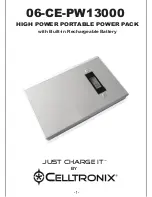
GENERAL SAFETY RULES
WARNING!
Read, understand and save all instructions. Failure to follow all
instructions listed below may result in electric shock, fire or serious personal injury. The
warnings, cautions, and instructions discussed in this instruction manual cannot cover all
possible conditions and situations that may occur. It must be understood by the operator
that common sense and caution are a factor which cannot be built into this product, but
must be supplied by the operator.
SAVE ALL INSTRUCTIONS!
WORK AREA
1.
Keep your work area clean and well organized. Cluttered benches and dark areas
invite accidents.
2.
Do not operate power tools in explosive atmospheres, such as in the presence of
flammable liquids, gases, or dust. Power tools create sparks which may ignite the
dust or fumes.
3.
Keep bystanders, children and visitors away while operating a power tool.
Distractions can cause you to lose control.
ELECTRICAL SAFETY
Do not abuse the cord. Never use the cord to carry the tool. Keep cord away from heat,
oil, sharp edges or moving parts. Replace damaged cords immediately. Damaged cords
may create a risk of fire.
PERSONAL SAFETY
1.
Stay alert, watch what you are doing and use common sense when operating a
power tool. Do not use tool while tired or under the influence of drugs, alcohol or
medication. A moment of inattention while operating power tools may result in
serious personal injury.
2.
Dress properly. Do not wear loose clothing or jewelry. Contain long hair. Keep your
hair, clothing and gloves away from moving parts. Wear protective goggles when
operating the machine. It is recommended to wear protective goggles, gloves, sturdy
non-slipping shoes and an apron.
3.
Avoid accidental starting. Be sure switch is in OFF position before connecting to a
power outlet. Carrying tools with your finger on the switch when the switch is ON
invites accidents. Disconnect tool from power outlet before carrying out any work on
the machine.
4.
Remove adjusting wrench before turning the tool on. A wrench or a key that is left
attached to a rotating part of the tool may result in personal injury
5.
Do not overreach. Keep proper footing and balance at all times. Proper footing and
balance enables better control of the tool in unexpected situations.
6.
Use safety equipment. Always wear eye protection. Dust mask, non-skid safety
shoes, hard hat, or hearing protection must be used for
appropriate conditions.
TOOL USE AND CARE
1.
Use clamps or other practical way to secure and support the work piece to a stable
platform. Holding the work by hand or against your body is unstable and may lead to
loss of control.
2.
Do not force tool. Use the correct tool for your application. The correct tool will do
the job better and safer at the rate for which it is designed.
3.
Do not use tool if switch does not turn ON or OFF. Any tool that cannot be controlled
8







































